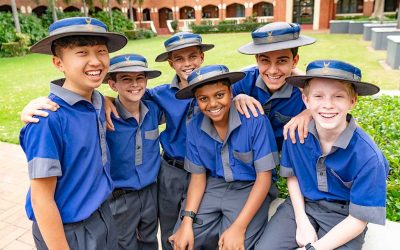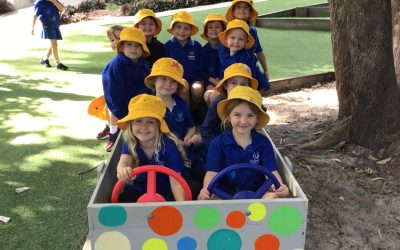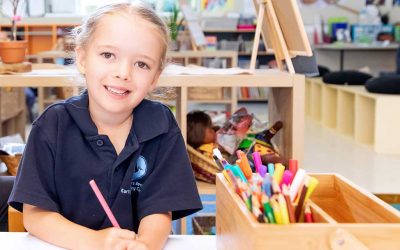With endless sources of information at your fingertips and the world changing faster than we have any hope of keeping up with, the traditional cookie-cutter style of learning that we grew up with is redundant. Teaching can no longer be about imparting selected knowledge and memorising content. Now it’s about developing agile thinkers and nurturing learners to have a growth mindset. And inquiry learning is at the forefront of this shift.
“Ours is a culture where mistakes are embraced as a pathway to growth,” says Rachelle Brutnell, Dean of Primary Prep to Year 3 at Sunshine Coast Grammar School.
Nowadays we know a lot more about neuroscience, the plasticity of brains and their ability to continually evolve. Having a growth mindset, being able to display flexible thinking and to view things from different perspectives, is critical now.
To prepare students for a globally connected and information data-driven world, schools acknowledge the need to drastically shift their approach to learning.
“We want to develop the next generation of young adults to have a deep understanding of themselves as learners, to be curious and to actively seek to question, trial, design and create solutions to problems in the world. We want our learners to connect, to understand and to empathise with people and the environment. To be creators and solution finders,” says Mrs Brutnell.
Mrs Brutnell believes that sparking this curiosity starts with the littlest learners, with a child-centered, inquiry approach being a valuable part of the Grammar Primary curriculum.
“An inquiry approach allows teachers to design opportunities for exploration and this is often centered around an initial question. Inquiry is certainly not limited to, but lends itself to the Science and Hass curriculum and it can increase learner agency by igniting student’s curiosity and connecting prior knowledge to areas of interest in the curriculum,” says Mrs Brutnell.
Through inquiry, students learn the skills of empathising, questioning, thinking, designing and reflecting. The many skills they gain through inquiry and design thinking are transferable; students can apply them to new contexts of learning. These are all valuable assets for children, as many of the jobs they may occupy don’t even exist yet.
“The UN sustainability goals are a shared blueprint for peace and prosperity for people and the planet. They are a call for action. We live in our world where we are more often asked to collaborate across the globe in a collective effort to seek solutions at a universal level. We want to nurture our students to be creative and flexible, we want them to seek out information to build on their existing experiences to extend and refine their thinking and ideas. Our students use thinking routines, “First I thought…, now I think…” and they often have to rethink or test their ideas and solutions several times,” says Mrs Brutnell.

Creating learner agency
The basis of this future-focused learning culture is around building ‘learning assets’ and instilling a love for learning. Learning assets are skills such as being a collaborator, a thinker, a communicator, a researcher, and a self-manager; those skills and dispositions that students need if they are to be successful in an evolving life of constant learning. To create learner agency in students—where they want to learn.
“A culture of curiosity and learning is something that is nurtured at Grammar from Prep all the way through to Year 12. Throughout the school, we focus on providing students with clarity in their learning through explicit learning intentions and understanding of the success criteria. It is through making thinking visible that we engage our students to question and wonder after their learning and the world around them,” says Mrs Brutnell.
“You want students exiting Year 12 who are thinkers that are willing to go out there and question the world and understand that you have to look at things from different perspectives. Young adults who can seek to have a positive impact in the world.” says Mrs Brutnell.
Creating a culture of learning must apply to teachers too.
“Everything that we ask of our students, we also ask of our teachers,” says Mrs Brutnell. “We want them to be lifelong learners, we want them to have those same dispositions. We want them to be researchers and onto the latest trends in education so that we’ve got best practice and we’re knowledgeable in what the future holds. I think the change in education is within both students and teachers.”
Related Reads
Your look beyond the doors at Grammar Early Learning Centre
Meet new Sunshine Coast Grammar School principal Anna Owen
Check out Sunshine Coast Grammar’s stunning new art precinct!
What does inquiry teaching look like?
Mrs Brutnell believes students need to do the heavy lifting in their learning, with teaching providing clarity and expectations.
“Teaching will and should look different in each classroom, as teachers choose from a range of approaches throughout their day to suit to their students’ needs and the learning intention. There will be teaching ranging from explicit instruction with the whole class, to teachers guiding individual students to independently take the next step in their learning.”
Through these carefully crafted lessons teachers encourage student to inquire, to question, to reflect and take their thinking further before they act. Students are not just given a question and left to their own devices. A good inquiry teacher will scaffold and nurture the learning and explicitly teach both knowledge and skills throughout the investigation.
“I think an inquiry approach is sometimes misunderstood. When undertaking an inquiry, teachers will front-load students with a learning intention, knowledge, skills and a success criteria in the initial phases of the unit. Teachers will engage their learners through provocations or a ‘hook’ to increase their students’ interest and to stimulate wonder and bring relevance to their new learning.
“Together the teacher and student influence the path of learning depending on the student’s prior knowledge and curiosity. This may look different for various students with the goal for all students to demonstrate the success criteria and satisfy the learning intention. Carefully guided by skilled teachers, inquiry can allow students to connect to their learning, dive deeper into a subject and to gain a larger conceptual understanding.” says Mrs Brutnell.

The new Early Years Precinct at Sunshine Coast Grammar School
The new Early Years Precinct at Sunshine Coast Grammar School has been designed to nurture and maximise access to inquiry, exploration and curiosity for their littlest learners.
“Exploring relationships of space, light and shape within its modern architecture, the curved structure can be likened to an eye wide open and taking in the world around it. It’s a very fitting metaphor, as the School sees its wide-eyed learners enter their journey in this aesthetic precinct in which every aspect has been carefully considered through the lens of a child,” says Mrs Brutnell.
The classrooms reflect new ideas and trends boasting teaching walls, high ceilings, reading nooks and purpose-built storage. Located on the second floor, the classrooms extend and merge into an enclosed gallery that offers a hybrid of outside/inside learning. The area also includes naturally styled carpet alcoves for small group learning.
The purpose-built child-sized teaching kitchen is a clever addition to the space, and offers plenty of opportunity for cooking, experiments and science.
“The teaching kitchen is a familiar setting for our Prep students—everyone has one in their home. It provides a wonderful way to connect their learning to their everyday life. Students have that knowledge of a kitchen as a creative area where family members may often be fine tuning and experimenting with recipes and ingredients. The teaching and shared learning spaces assist to nurture a love of STEAM (Science, Technology, Engineering, Arts, Maths) subjects as we can cook, experiment, design and create in this space.”
By placing the classrooms on the first level, the precinct has a cool ground floor space that supports a broad range of activities including learning, perceptual motor program and play. The large undercroft will allow students to escape the elements and adds to the sensory landscaped playground.
“We live and learn in an amazing tropical part of the world that has seen an increase in wet weather patterns with predictions of more to come. We wanted to ensure we could continue to provide our youngest learners with the highly-desired opportunities for physical movement, gross motor skill development and play, regardless of the weather conditions,” says Mrs Brutnell.
Yet, success is about more than architecture
Though impressive facilities are nice, successful learning is about so much more than the building it happens in.
“I think it comes down to relationships—the teachers’ and the students’ relationships are still the fundamental core of what drives who we are at Grammar and our community. We always put our students at the heart of everything that we do,” says Mrs Brutnell.
“Our goal is to drive curiosity and a love of learning through learning agency. We have teachers who are delving themselves into current research and making sure they’re on top of good practice and then being encompassed by an amazing building, it just makes for a lovely recipe for success in learning.”


